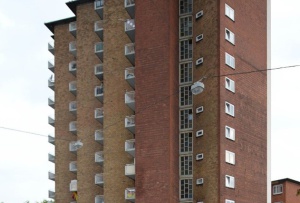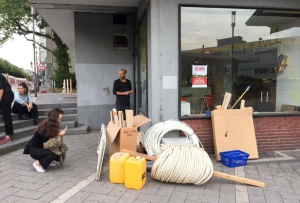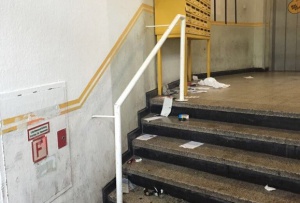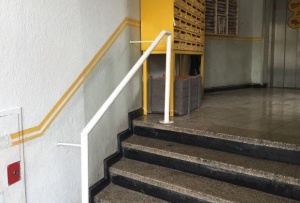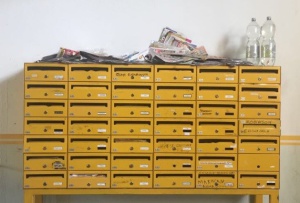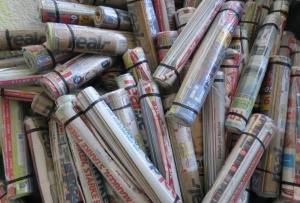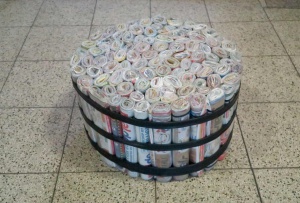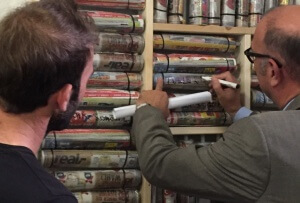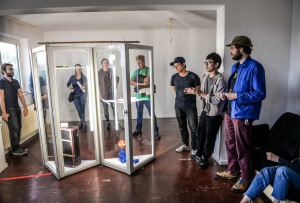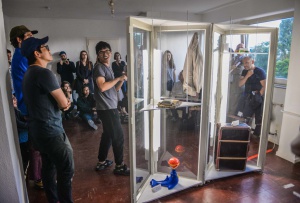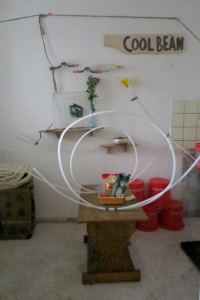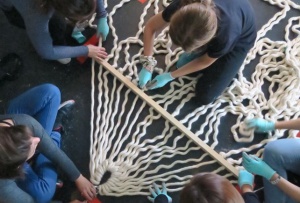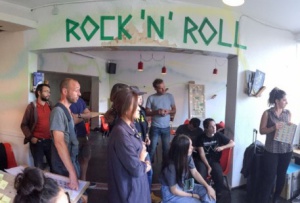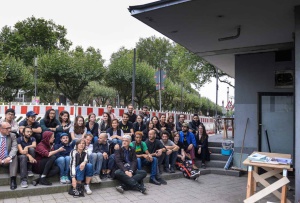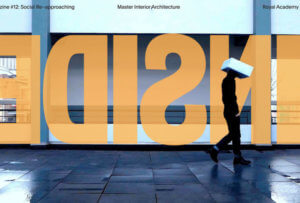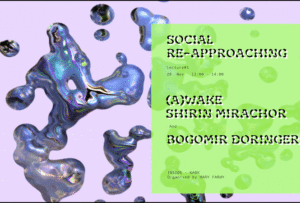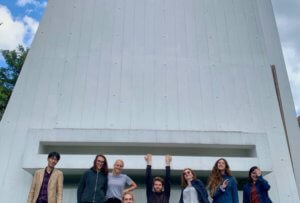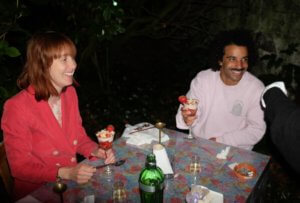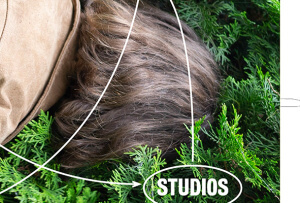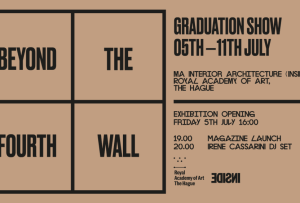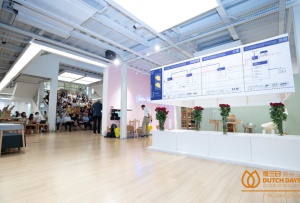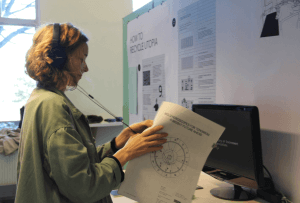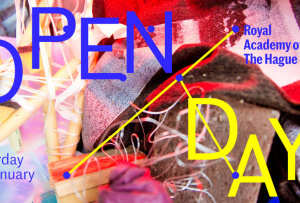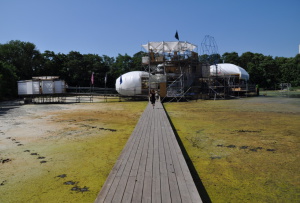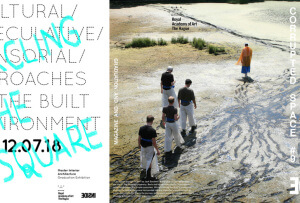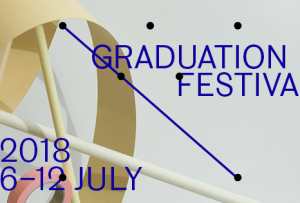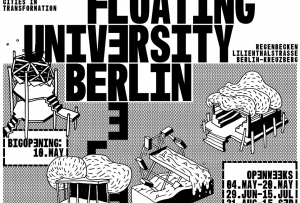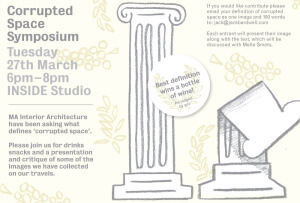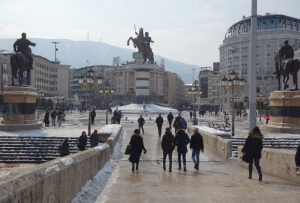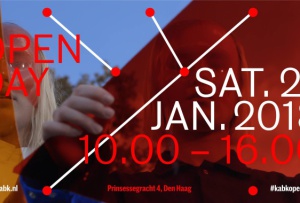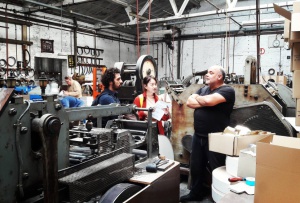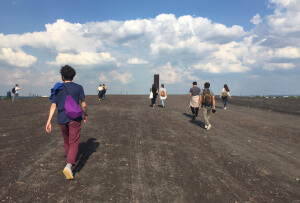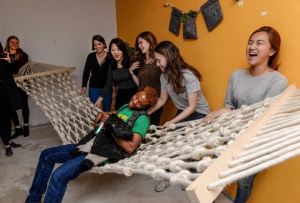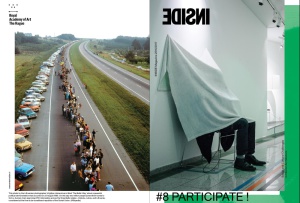The OBERHAUS introduction week
During the first week of september INSIDE students worked in the Ruhr area in Germany. In a high-rise building at the central station in Oberhausen: 12 floors, 82 apartments. Since many years that building is known as «the problem-house» in the already tenuous area of the old city centre. That image is even worse. The number of vacantness and the fluctuation were extremely high. Now many refugees have moved into the apartments of the high-rise. With kitev, (culture in the tower), the laboratory for unusual interventions and resident in the watertower of Oberhausen’s central train station, that situation sparked the idea ‘Oberhaus’ and led to the Project Refugees for Co-Creative Cities. As a contribution to this project INSIDE students, guided by Jan Körbes from REFUNC, harvested materials in the direct environment of The Oberhaus and designed four collective ‘services’ in the building together with inhabitants. These new collective spaces will support these inhabitants that to a great extent have a refugee background, to create a stronger ‘sense of belonging’ in their new Heimat. Now that the big housing challenge after the wave of refugees that entered Europe in 2015-2016 is solved, the next challenge is to incorperate and make these refugees feel part of the european society.
-
The Oberhaus
-
Harvesting waste material
Dirty reality
At first entry the students could not help to be somewhat shocked by the garbage in the hallway, the dirt on the floor and the walls and the unpleasent smell in the collective spaces of the Oberhaus. The building was clearly not well maintained by the inhabitants. This turned out to be a signal for the lack of collectivity in the building. The Oberhaus is a ‘halfway house’ a place people come with no other housing options. The inhabitants hardly have relationships or even contact with eachother. Their main ambition seems to be to move out again as soon as possible.
The first thing the participants of the workshop did was to buy cleaning products and firmly brush the hallway of the building. That action sparked two ideas for redirecting the neverending flow of garbage in the building in a positive direction.
Beauty for free
When entering the building you can not avoid the piles of advertising folders that the distributors did not even care to stick into the individual mailboxes. Students started researching the qualities of these packages of printed sheets of paper wrapped in plastic. When rolled up (cleaverly held together with rings of rubber cut from old bicycle tire a local shop donated) these packages turned out to be a buidling material with unexpected potentials. Within the easy-to-fill frames the students developed, these folders can create message boards for instance and even are suitable to use for building seats, bookshelves and tables. The piles of printed matter that are thrown into the hallway of the building every week provide unexpected possibilities to create useful and even beautiful ‘services’.
(a project by: janneke -lucinda-daniele-hande-adriel with thanks to: Saleh – Moayad – Omar – Achmad – Simon – Merve – Erdem and Yamina)
Precious garbage cabinet
Not only in the hallway but throughout the whole building you can find rubbish that inhabitants have carelessly thrown away. In the midst of that waste students have found materials that deserve a second life. They found dumped computers, televisionscreens, toys and waste magazines for instance that could be easily repaired, cleaned and re-used by someone else than the person that got rid of it. This reuse starts with the revaluation of the dumped items, to change the perspective on garbage. To start that perspective-change students build a cabinet from thrown away window frames (only the screws were bought) in that they carefully placed the reusable items they have found. Where possible the items were personalized by including their history, the story of their past life with previous users. Suddenly these items look precious, and shining in the glass cabinets, they radiate value instead of worthlessness. The cabinet is a ‘swop-shop’ that revaluates the garbage and links these to a new future. By being aware of the stories of these items, the reusers are connected to the former users and their histories.
(a project by: jack-i chieh-hangpin with thanks to: Saleh – Moayad – Omar – Achmad – Simon – Merve – Erdem and Yamina)
Playful guestroom
With their Oberhaus project kitev initiated an artistic approach to upgrade a neglected building near the Oberhausen train station and improve the housing situation in the city quarter. The project focuses on fostering the intercultural dialogue between current and future neighbours to create a better life. To enable the intercultural dialogue, kitev recently rented two of the apartments in the building. In future kitev plans to develop collective spaces in these apartments. But first the inhabitants, that can not at all be seen as a community, need to be invited, or even provoked to cooperate in the project. Together with the inhabitants kitev then is able to reveal the HEIMAT-potentials of the place and define necessary spatial changes to start a community. As an invitation to participate, in one of the apartments students developed a ‘playful guestroom’. A space that can be used by the inhabitants to ‘hang out’ with guests.
Cool beans
The kitchen in the guestroom apartment does not have to provide possibilities to cook for large families everyday. Apart from preparing an occasional cup of tea or sandwich, this kitchen offers possibilities for playful interventions. Students started developing a circuit of movement, sound and food through the otherwise barely furnished kitchen space. For that they used materials they found in the proximity of the building. Their installation joyfully celebrates the kitchen as a machine where one movement provokes the next. As an ultimate act of coincidence, the installation finally leads to the launch of a handful of beans onto the miniature ‘suitcase-garden’ they built on the small balcony connected to the apartment. There the beans land on fertile soil in a accidental order and can start growing.
(a project by: jaja-cam-zara with thanks to: Saleh – Moayad – Omar – Achmad – Simon – Merve – Erdem and Yamina)
Inside garden hang-out
Where you would undoubtedly expect to find the best re-usable materials at the numerous factories and waste processors in the Ruhr area, this project started in the cellar of the artist initiative kitev. There piles of thick rope were lying around after being purchased for an art project. Students took these ropes apart and started reconnecting, tying and even knitting with the material. Soon they shaped hammocks, a furniture typology you can find all over the world, that is both a practical aswell as a recreational way of hanging around in open air. From isolation materials they also found in kitevs cellars, students sew pockets for plants with that they recreated a hanging garden in the guest apartment. Thus completing a playful Inside garden hang-out in an area without an abundance of parks, collective gardens and other kinds of green public spaces. Inviting the inhabitants to relax, have fun and connect by playing in their own garden.
(a project by: jinaa-yungkung-laura-shin-lotti with thanks to: Saleh – Moayad – Omar – Achmad – Simon – Merve – Erdem and Yamina)
Invitation to start
The installation the students developed in cooperation with the participating inhabitants and architects from the Istanbul based collective ‘Architecture for all’ did not completely define and facilitate the collective spaces to create a community in the Oberhaus building as kitev intends. That would obviously be somewhat ambitious for a four day student project. The interventions however undoubtedly contain the potentials of inviting the inhabitants to participate, to provoke through that new connections between them and to enable the coming of existence of a new community in Oberhausen. (Oberhausen september 7 2017)
A project of:
– 16 master students from INSIDE (Royal Academy of Art The Hague):
Jack Bardwell – Lotti Gostič – Hande Öğün – Hangping Yang – Adriel Quiroz Silva – Laura Frias Munoz del Cerro – Huaxin Zhang – Yunkyung Lee – Daniele Valentino – I-Chieh Liu – Zara Bennett – Jinaa Baek – Janneke Derksen – Shinyoung Kang – Pichaya Puapoomcharoen – Yuan-Chun Liu
– 5 residents from the Oberhaus:
Saleh Jumaa – Moayad Nadaf – Omar Sheko – Achmad Abbas – Simon Mellnich
– 2 representatives from the Istanbul based cooperative ‘Herkes İçin Mimarlık herkes’ (architecture for all) http://herkesicinmimarlik.org: Merve Gül Özokcu – Erdem Üngür
– REFUNC – Jan Körbes – Yamina Baumgartner http://refunc.nl
– kitev – Agnieszka Wnuczak – Christoph Stark – Stefan Schroer – Gesina Rath – Fatima Caliskan – http://kitev.de
– INSIDE – Hans Venhuizen – Erik Jutten – Lotte van den Berg – http://enterinside.nl
– With special thanks for introducing the Ruhr area: Christine Bleks (Tausche Bildung für Wohnen – Duisburg-Marxloh) – Jan Bunse (die Urbanisten Dortmund) – André Dekker – Geert van de Camp (Observatorium – Warten auf den Fluss Essen) – Reinhild Kuhn (Heimatdesign Dortmund)
Links:
